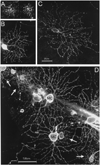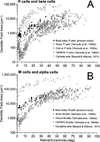Morphology of P and M retinal ganglion cells of the bush baby
- PMID: 9893847
- PMCID: PMC3341668
- DOI: 10.1016/s0042-6989(97)00412-4
Morphology of P and M retinal ganglion cells of the bush baby
Abstract
P/midget ganglion cells mediate red-green color opponency in anthropoids. It has been proposed that these cells evolved as a specialization to subserve color vision in primates. If that is correct, they must have evolved about the same time as the long-wavelength ('red') and medium-wavelength ('green') pigment genes diverged, thirty million years ago. Strepsirhines are another group of primates that diverged from the ancestor of the anthropoids at least 55 million years ago. If P/midget ganglion cells evolved to subserve color vision, they should be absent in strepsirhines. We tested this hypothesis in a nocturnal strepsirhine, the greater bush baby Otolemur. The retinal ganglion cells were labeled with the lipophilic tracer Dil and the results show that bush babies have P/midget and M/parasol cells similar to those found in the peripheral retinas of anthropoids. A number of studies have shown that the P and M pathways of bush babies share many similarities with those of anthropoids, and our results show that the same is true for their retinal ganglion cells. These results support the hypothesis that the P system evolved prior to the emergence of red-green color opponency.
Figures



Similar articles
-
Nonselective Wiring Accounts for Red-Green Opponency in Midget Ganglion Cells of the Primate Retina.J Neurosci. 2018 Feb 7;38(6):1520-1540. doi: 10.1523/JNEUROSCI.1688-17.2017. Epub 2018 Jan 5. J Neurosci. 2018. PMID: 29305531 Free PMC article.
-
Morphology and physiology of primate M- and P-cells.Prog Brain Res. 2004;144:21-46. doi: 10.1016/S0079-6123(03)14402-0. Prog Brain Res. 2004. PMID: 14650838 Review.
-
Ganglion cells of a short-wavelength-sensitive cone pathway in New World monkeys: morphology and physiology.Vis Neurosci. 1999 Mar-Apr;16(2):333-43. doi: 10.1017/s0952523899162138. Vis Neurosci. 1999. PMID: 10367967
-
Distinct synaptic mechanisms create parallel S-ON and S-OFF color opponent pathways in the primate retina.Vis Neurosci. 2014 Mar;31(2):139-51. doi: 10.1017/S0952523813000230. Epub 2013 Jul 29. Vis Neurosci. 2014. PMID: 23895762 Free PMC article. Review.
-
L and M cone contributions to the midget and parasol ganglion cell receptive fields of macaque monkey retina.J Neurosci. 2004 Feb 4;24(5):1079-88. doi: 10.1523/JNEUROSCI.3828-03.2004. J Neurosci. 2004. PMID: 14762126 Free PMC article.
Cited by
-
Color vision diversity and significance in primates inferred from genetic and field studies.Genes Genomics. 2016;38:779-791. doi: 10.1007/s13258-016-0448-9. Epub 2016 Jul 6. Genes Genomics. 2016. PMID: 27594978 Free PMC article. Review.
-
Retinal connectivity and primate vision.Prog Retin Eye Res. 2010 Nov;29(6):622-39. doi: 10.1016/j.preteyeres.2010.08.004. Epub 2010 Sep 6. Prog Retin Eye Res. 2010. PMID: 20826226 Free PMC article.
-
Age and Environment Influences on Mouse Prion Disease Progression: Behavioral Changes and Morphometry and Stereology of Hippocampal Astrocytes.Oxid Med Cell Longev. 2017;2017:4504925. doi: 10.1155/2017/4504925. Epub 2017 Jan 24. Oxid Med Cell Longev. 2017. PMID: 28243355 Free PMC article.
-
The marmoset monkey as a model for visual neuroscience.Neurosci Res. 2015 Apr;93:20-46. doi: 10.1016/j.neures.2015.01.008. Epub 2015 Feb 13. Neurosci Res. 2015. PMID: 25683292 Free PMC article. Review.
-
Processing of S-cone signals in the inner plexiform layer of the mammalian retina.Vis Neurosci. 2014 Mar;31(2):153-63. doi: 10.1017/S0952523813000308. Epub 2013 Sep 9. Vis Neurosci. 2014. PMID: 24016424 Free PMC article. Review.
References
-
- Kay RF, Ross C, Williams BA. Anthropoid origins. Science. 1997;272:797–804. - PubMed
-
- Fleague JG. Primate Adaptation and Evolution. San Diego: Academic Press; 1988.
-
- Casagrande VA, Kaas JH. The afferent, intrinsic, and efferent connections of primary visual cortex in primates. In: Peters A, Rockland KS, Jones EG, editors. Cerebral Cortex, vol. 10, Primary Visual Cortex in Primates. New York: Plenum Press; 1994. pp. 201–259. series editors.
-
- Jacobs GH, Neitz M, Neitz J. Mutations in S-cone pigment genes and the absence of colour vision in two species of nocturnal primate. Proc R Soc B (Lond) 1996;263:705–710. - PubMed
Publication types
MeSH terms
Grants and funding
LinkOut - more resources
Full Text Sources

